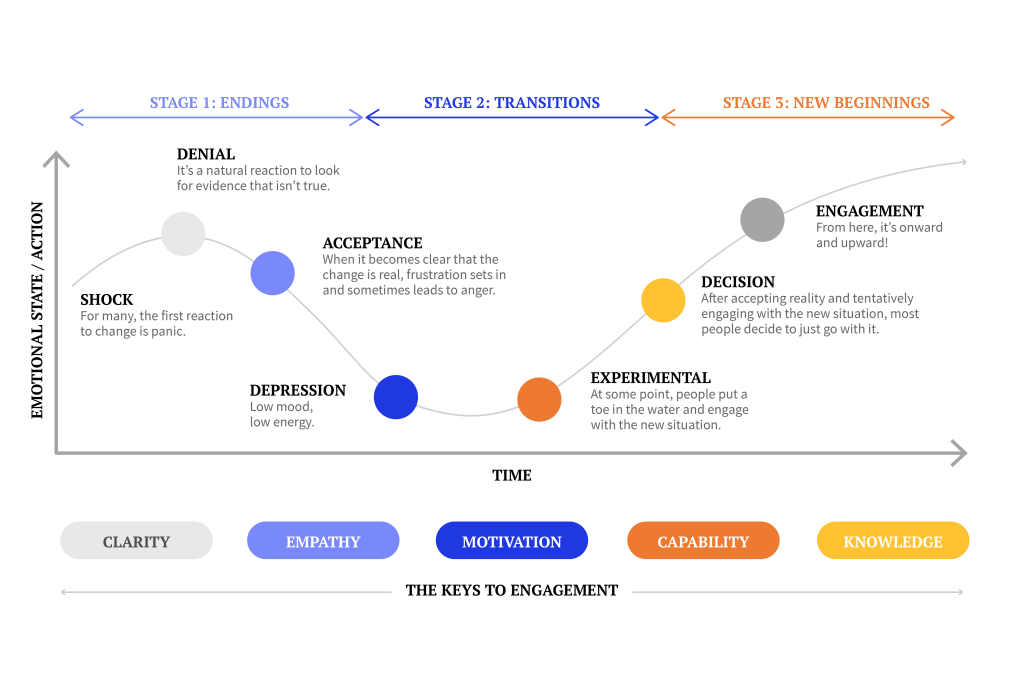Change is a constant in our lives, from small routine changes to big ones like relocating or switching jobs. In business, change is essential for staying competitive and keeping up with evolving customer and market trends. But embracing change can be challenging for individuals and organisations alike. In fact, a Harvard Business Review study found that 70% of change programs fail due to employee resistance and lack of management support.
This article explores how individuals typically respond to change and the appropriate leadership strategies to support them throughout the process.
What drives resistance to change?
Fear, uncertainty, and a lack of trust often drive resistance to change. People may be comfortable with their existing ways of working and resist change because they do not want to disrupt their routine or familiar way of doing things. Within a workplace environment, individuals may feel anxious or overwhelmed by the prospect of change, impacting their motivation and productivity.
Understanding how individuals typically cope with change

Kubler-Ross’ change curve illustrates the emotional journey people experience during significant change. The model has seven stages: shock, denial, frustration, depression, experiment, decision, and integration. It provides a framework for understanding how individuals react to change and how they can adjust. As shown by the curve, it’s common for individuals to resist change at first before moving to ‘decision’ and ‘engagement’.
However, it’s important to note the model is not perfect. Individuals may experience stages in different orders, skip stages, or move back and forth. The model also does not account for cultural or social factors influencing how people cope with change.
Despite its limitations, the Kubler-Ross Change Curve remains useful for understanding the emotional journey of change and navigating the adjustment process.
The keys to engagement during change
Ultimately, as a leader of change, your goal is to encourage individuals towards the stage of ‘decision’ and ‘engagement’. Here is where they truly embrace change and decide to move forward with it. Most individuals need some help to get to this stage, and this is where a good leader shines.
A study published in the European Journal of Work and Organisational Psychology found that contextual factors, such as a lack of trust in management or poor communication, can be associated with increased resistance to change. When change is imposed on employees without proper communication, transparency, or support, employees may resist it out of fear of the unknown or a perceived threat to their job security.
So, how can you meet the needs of individuals as they move through the various stages of the curve?

| Emotional state | Response | Why? |
| Shock/ denial | Clarity | Leaders should communicate clearly, outlining why the changes are necessary, what they will entail, and how they will impact individuals. Clarify what will stay the same, helping minimise confusion and frustration and build a level of trust in management. |
| Acceptance | Empathy | Individuals want to feel reassured. Show individuals that you understand that change is difficult. |
| Depression | Motivation | Highlight the benefits of the change. Individuals should be empowered to provide feedback and raise any concerns or questions they may have. In a recent study, McKinsey found that when people are truly invested in change, it is 30% more likely to stick. |
| Experimental | Capability | Building on the feedback and questions, leaders should work with individuals to remove any obstacles and help them embrace the change effectively. Leaders should provide support and resources to help employees navigate the changes. |
| Decision/ engagement | Knowledge | Lastly, leaders should provide continued knowledge through new insights, information, and any details that will help them continue to embrace change. |
How does emotional intelligence influence change?
Emotional intelligence is a critical component of effective leadership. Leaders must understand and manage their own emotions and those of others, build strong relationships, foster a positive work environment, and inspire and motivate their team members.
To achieve this, leaders should try to ‘listen with fascination’, treating each person as they want to be treated. For instance, one person might need empathy, whilst another seeks motivation or clarity. That’s the complexity of leading change. It’s important for leaders to really take in any comments, feedback, or questions to understand individual needs.
In summary, by addressing each individual’s root causes of resistance, leaders can implement appropriate emotional responses to help their team navigate change. This takes patience. Everyone will respond differently and, as such, take varying lengths of time to embrace change. Some may never get to the stage of engagement.
If you’d like to talk to us about ongoing or planned change programmes, email [email protected]. We’d be delighted to hear from you.



